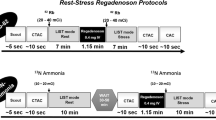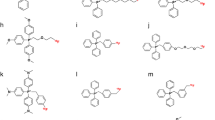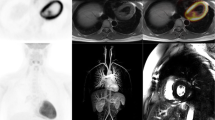Abstract
In the recent years, hybrid positron emission tomography (PET)/computed tomography (CT) scanners have been increasingly utilized in cardiac applications. PET imaging quality has been improved by the use of new scintillators, small detector element size, and fully 3D iterative reconstruction techniques with time-of-flight information and resolution recovery. Further quality enhancements for cardiac imaging can be obtained by tracking and correcting for cardiac and breathing motion with respiratory gating devices and advanced software techniques. The primary tracers used for PET/CT cardiac imaging are Rubidium-82 (82Rb) and Nitrogen-13-ammonia (13N-ammonia) and 18-F fluorodeoxyglucose used for myocardial viability imaging. A new F-18 perfusion tracer (F-18 Flurpiridaz) is being evaluated. High-resolution multi-slice CT component of the hybrid scanner allows accurate attenuation correction for PET, measurement of CT calcium, and contrast CT angiography. Hybrid PET/CT protocols have demonstrated increased diagnostic accuracy for the detection of obstructive disease compared with standalone techniques. Radiation dose to the patient is a concern in hybrid imaging because multiple scans are performed in one scanning session. 3D PET acquisition combined with the new low-dose CT protocols can reduce the doses significantly. Hybrid PET/CT scanners have also been utilized for anatomically-guided molecular imaging of plaque biology in the carotid vessels, aorta, and coronary vessels. This review summarizes the state-of-the-art hybrid imaging PET/CT instrumentation and advances in the image quality related to cardiac imaging.








Similar content being viewed by others
References
Papers of particular interest, published recently, have been highlighted as: • Of importance •• Of major importance
Koepfli P, Hany TF, Wyss CA, et al. CT attenuation correction for myocardial perfusion quantification using a PET/CT hybrid scanner. J Nucl Med. 2004;45:537–42.
Dorbala S, Vangala D, Sampson U, et al. Value of vasodilator left ventricular ejection fraction reserve in evaluating the magnitude of myocardium at risk and the extent of angiographic coronary artery disease: a 82Rb PET/CT study. J Nucl Med. 2007;48:349–58.
Slomka PJ, Dey D, Duvall WL, et al. Advances in nuclear cardiac instrumentation with a view towards reduced radiation exposure. Curr Cardiol Rep. 2012;14:208–16.
Bettinardi V, Presotto L, Rapisarda E, et al. Physical performance of the new hybrid PET∕ CT Discovery-690. Med Phys. 2011;38:5394–411.
Surti S, Kuhn A, Werner ME, et al. Performance of Philips Gemini TF PET/CT scanner with special consideration for its time-of-flight imaging capabilities. J Nucl Med. 2007;48:471–80.
Jakoby B, Bercier Y, Conti M, et al. Physical and clinical performance of the mCT time-of-flight PET/CT scanner. Phys Med Biol. 2011;56:2375–89.
Klein R, Beanlands RS, deKemp RA. Quantification of myocardial blood flow and flow reserve: technical aspects. J Nucl Cardiol. 2010;17:555–70.
Cui J-Y, Pratx G, Prevrhal S, Levin CS. Fully 3D list-mode time-of-flight PET image reconstruction on GPUs using CUDA. Med Phys. 2011;38:6775–86.
Pratx G, Surti S, Levin C. Fast list-mode reconstruction for time-of-flight PET using graphics hardware. IEEE Trans Nucl Sci. 2011;58:105–9.
Esteves F, Nye J, Khan A, et al. Prompt-gamma compensation in Rb-82 myocardial perfusion 3D PET/CT. J Nucl Cardiol. 2010;17:247–53.
Jakoby BW, Bercier Y, Conti M, et al. Physical and clinical performance of the mCT time-of-flight PET/CT scanner. Phys Med Biol. 2011;56:2375–89 [Epub 2011 Mar 22].
Lois C, Jakoby BW, Long MJ, et al. An assessment of the impact of incorporating time-of-flight information into clinical PET/CT imaging. J Nucl Med. 2010;51:237–45.
Tipnis S, Hu Z, Gagnon D, O’Donnell J. Time-of-flight PET for Rb-82 cardiac perfusion imaging. J Nucl Med. 2008;49 Suppl 1:74P.
Panin VY, Kehren F, Michel C, Casey M. Fully 3-D PET reconstruction with system matrix derived from point source measurements. IEEE Trans Med Imaging. 2006;25:907–21.
Akamatsu G, Ishikawa K, Mitsumoto K, et al. Improvement in PET/CT image quality with a combination of Point-Spread function and Time-of-Flight in relation to reconstruction parameters. J Nucl Med. 2012;53:1716–22.
Le Meunier L, Slomka P, Dey D, et al. Enhanced definition PET for cardiac imaging. J Nucl Cardiol. 2010;17:414–26.
Nakazato R, Berman DS, Dey D, et al. Automated quantitative Rb-82 3D PET/CT myocardial perfusion imaging: normal limits and correlation with invasive coronary angiography. J Nucl Cardiol. 2012;19:265–76.
Slomka PJ, Alexanderson E, Jacome R, et al. Comparison of clinical tools for measurements of regional stress and rest myocardial blood flow assessed with 13N-ammonia PET/CT. J Nucl Med. 2012;53:171–81.
Berman DS, Maddahi J, Tamarappoo B, et al. Phase II safety and clinical comparison with single-photon emission computed tomography myocardial perfusion imaging for detection of coronary artery disease Flurpiridaz F 18 Positron Emission Tomography. J Am Col Cardiol. 2013;61:469–77.
Woo J, Tamarappoo B, Dey D, et al. Automatic 3D registration of dynamic stress and rest (82)Rb and flurpiridaz F 18 myocardial perfusion PET data for patient motion detection and correction. Med Phys. 2011;38:6313–26.
Kaster T, Mylonas I, Renaud JM, et al. Accuracy of low-dose rubidium-82 myocardial perfusion imaging for detection of coronary artery disease using 3D PET and normal database interpretation. J Nucl Cardiol. 2012;19:1135–45.
Zaidi H. Is radionuclide transmission scanning obsolete for dual-modality PET/CT systems? Eur J Nucl Med Mol Imaging. 2007;34:815–8.
Pan T, Mawlawi O, Nehmeh SA, et al. Attenuation correction of PET images with respiration-averaged CT images in PET/CT. J Nucl Med. 2005;46:1481–7.
Bacharach SL. PET/CT attenuation correction: breathing lessons. J Nucl Med. 2007;48:677–9.
Gould KL, Pan T, Loghin C, et al. Frequent diagnostic errors in cardiac PET/CT due to misregistration of CT attenuation and emission PET images: a definitive analysis of causes, consequences, and corrections. J Nucl Med. 2007;48:1112–21.
Slomka PJ, Le Meunier L, Hayes SW, et al. Comparison of myocardial perfusion 82Rb PET performed with CT- and transmission CT-based attenuation correction. J Nucl Med. 2008;49:1992–8.
Nordberg P, Declerck J, Brady M. Pre-reconstruction rigid body registration for positron emission tomography: an initial validation against ground truth. Conf Proc IEEE Eng Med Biol Soc. 2010;2010:5612–5.
Alessio AM, Kohlmyer S, Branch K, et al. Cine CT for attenuation correction in cardiac PET/CT. J Nucl Med. 2007;48:794–801.
Fayad HJ, Lamare F, Le Rest CC, et al. Generation of 4-Dimensional CT images based on 4-dimensional PET–derived motion fields. J Nucl Med. 2013; (in press).
Di Carli MF, Dorbala S, Hachamovitch R. Integrated cardiac PET-CT for the diagnosis and management of CAD. J Nucl Cardiol. 2006;13:139–44.
Danad I, Raijmakers PG, Appelman YE, et al. Hybrid imaging using quantitative H215O PET and CT-based coronary angiography for the detection of coronary artery disease. J Nucl Med. 2013;54:55–63.
Nakazato R, Dey D, Alexanderson E, et al. Automatic alignment of myocardial perfusion PET and 64-slice coronary CT angiography on hybrid PET/CT. J Nucl Cardiol. 2012;19:482–91.
Gaemperli O, Bengel FM, Kaufmann PA. Cardiac hybrid imaging. Eur Heart J. 2011;32:2100–8.
Flotats A, Knuuti J, Gutberlet M, et al. Hybrid cardiac imaging: SPECT/CT and PET/CT. A joint position statement by the European Association of Nuclear Medicine (EANM), the European Society of Cardiac Radiology (ESCR), and the European Council of Nuclear Cardiology (ECNC). Eur J Nucl Med Molec. Imaging. 2011;38:201–12.
Namdar M, Hany TF, Koepfli P, et al. Integrated PET/CT for the assessment of coronary artery disease: a feasibility study. J Nucl Med. 2005;46:930–5.
Slomka PJ, Cheng VY, Dey D, et al. Quantitative analysis of myocardial perfusion SPECT anatomically guided by coregistered 64-slice coronary CT angiography. J Nucl Med. 2009;50:1621–30.
Kajander S, Joutsiniemi E, Saraste M, et al. Cardiac Positron Emission Tomography/Computed Tomography imaging accurately detects anatomically and functionally significant coronary artery disease: clinical perspective. Circulation. 2010;122:603–13.
Kajander S, Ukkonen H, Sipilä H, et al. Low radiation dose imaging of myocardial perfusion and coronary angiography with a hybrid PET/CT scanner. Clin Physiol Functional Imaging. 2009;29:81–8.
Achenbach S, Goroll T, Seltmann M, et al. Detection of coronary artery stenoses by low-dose, prospectively ECG-triggered, high-pitch spiral coronary CT angiography. JACC Cardiovasc Imaging. 2011;4:328–37.
Hong C, Becker CR, Schoepf UJ, et al. Coronary artery calcium: absolute quantification in nonenhanced and contrast-enhanced multi–detector row CT studies. Radiology. 2002;223:474–80.
Schenker MP, Dorbala S, Hong ECT, et al. Interrelation of coronary calcification, myocardial ischemia, and outcomes in patients with intermediate likelihood of coronary artery disease. Circulation. 2008;117:1693–700.
Kim KP, Einstein AJ, Berrington de Gonzalez A. Coronary artery calcification screening: estimated radiation dose and cancer risk. Arch Int Med. 2009;169:1188.
• Burkhard N, Herzog BA, Husmann L, et al. Coronary calcium score scans for attenuation correction of quantitative PET/CT 13 N-ammonia myocardial perfusion imaging. Eur J Nucl Med Mol Imaging. 2010;37:517–21. Demostrates the use of calcium scoring scans for attenuation correction on PET/CT scanner.
Einstein AJ, Johnson LL, Bokhari S, et al. Agreement of visual estimation of coronary artery calcium from low-dose CT attenuation correction scans in hybrid PET/CT and SPECT/CT with standard Agatston score. J Am Coll Cardiol. 2010;56:1914–21.
Mylonas I, Kazmi M, Fuller L, et al. Measuring coronary artery calcification using positron emission tomography-computed tomography attenuation correction images. Eur Heart J Cardiovasc Imaging. 2012;13:786–92.
Martinez-Möller A, Zikic D, Botnar RM, et al. Dual cardiac–respiratory gated PET: implementation and results from a feasibility study. Eur J Nucl Med Molec Imaging. 2007;34:1447–54.
Büther F, Dawood M, Stegger L, et al. List mode–driven cardiac and respiratory gating in pet. J Nucl Med. 2009;50:674–81.
Slomka PJ, Nishina H, Berman DS, et al. “Motion-Frozen” display and quantification of myocardial perfusion. J Nucl Med. 2004;45:1128–34.
Le Meunier L, Slomka PJ, Dey D, et al. Motion frozen (18)F-FDG cardiac PET. J Nucl Cardiol. 2011;18:259–66.
Le Meunier L, Slomka P, Fermin JS, et al. Motion frozen of dual gated (cardiac and respiratory) PET images. J Nucl Med. 2009;50 Suppl 2:1474 [Abstract].
Di Carli MF, Dorbala S, Meserve J, et al. Clinical myocardial perfusion PET/CT. J Nucl Med. 2007;48:783–93.
•• Senthamizhchelvan S, Bravo PE, Esaias C, et al. Human biodistribution and radiation dosimetry of 82Rb. J Nucl Med. 2010;51:1592–9. Presents revised radiation dosimetry of the 82Rb data.
Knuuti J. Integrated positron emission tomography/computed tomography (PET/CT) in coronary disease. Heart. 2009;95:1457–63.
Maddahi J, Schelbert H, Brunken R, Di Carli M. Role of thallium-201 and PET imaging in evaluation of myocardial viability and management of patients with coronary artery disease and left ventricular dysfunction. J Nucl Med. 1994;35:707–15.
Vancraeynest D, Pasquet A, Roelants V, et al. Imaging the vulnerable plaque. J Am Coll Cardiol. 2011;57:1961–79.
Wykrzykowska JLS, Williams G, Parker JA, Palmer MR, Varkey S, Kolodny G, et al. Imaging of inflamed and vulnerable plaque in coronary arteries with 18F-FDG PET/CT in patients with suppression of myocardial uptake using a low-carbohydrate, high-fat preparation. J Nucl Med. 2009;50:563–8.
Rogers IS, Nasir K, Figueroa AL, et al. Feasibility of FDG imaging of the coronary arteries: comparison between acute coronary syndrome and stable angina. JACC Cardiovasc Imaging. 2010;3:388–97.
Cheng VY, Slomka PJ, Le Meunier L, et al. Coronary arterial 18F-FDG uptake by fusion of PET and coronary CT angiography at sites of percutaneous stenting for acute myocardial infarction and stable coronary artery disease. J Nucl Med. 2012;53:575–83.
Dweck MR, Chow MW, Joshi NV, et al. Coronary arterial 18F-sodium fluoride uptake: a novel marker of plaque biology. J Am Coll Cardiol. 2012;59:1539–48.
Judenhofer MS, Wehrl HF, Newport DF, et al. Simultaneous PET-MRI: a new approach for functional and morphological imaging. Nat Med. 2008;14:459–65.
Antoch G, Bockisch A. Combined PET/MRI: a new dimension in whole-body oncology imaging? Eur J Nucl Med Mol Imaging. 2009;36:113–20.
Heiss W-D. The potential of PET/MR for brain imaging. Eur J Nucl Med Mol Imaging. 2009;36:105–12.
Rischpler C, Nekolla SG, Dregely I, Schwaiger M. Hybrid PET/MR imaging of the heart: potential, initial experiences, and future prospects. J Nucl Med. 2013;54:402–15.
Anagnostopoulos C, Georgakopoulos A, Pianou N, Nekolla SG. Assessment of myocardial perfusion and viability by Positron Emission Tomography. Int J Cardiol. 2013; (in press).
Hofmann M, Pichler B, Schölkopf B, Beyer T. Towards quantitative PET/MRI: a review of MR-based attenuation correction techniques. Eur J Nucl Med Mol Imaging. 2009;36:93–104.
Conflict of Interest
Cedars-Sinai Medical Center receives royalties for the quantitative assessment of function, perfusion, and viability, a portion of which is distributed to the authors of this manuscript.
Author information
Authors and Affiliations
Corresponding author
Rights and permissions
About this article
Cite this article
Slomka, P.J., Berman, D.S. & Germano, G. State of the Art Hybrid Technology: PET/CT. Curr Cardiovasc Imaging Rep 6, 328–337 (2013). https://doi.org/10.1007/s12410-013-9208-2
Published:
Issue Date:
DOI: https://doi.org/10.1007/s12410-013-9208-2




